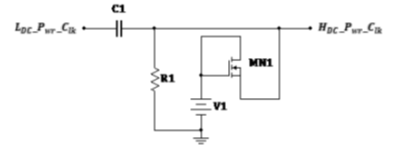


Indian Journal of Science and Technology
DOI: 10.17485/IJST/v14i33.1820
Year: 2021, Volume: 14, Issue: 33, Pages: 2671-2683
Original Article
Seyed E Esmaeili1*, Abeer Imdoukh2
1Assistant Professor, Engineering Department, American University of Kuwait, Safat, 13034, Salmiya, Kuwait
2Instructional Assistant, Engineering Department, American University of Kuwait, Safat, 13034, Salmiya, Kuwait
*Corresponding Author
Email: [email protected]
Received Date:06 October 2021, Accepted Date:23 September 2021, Published Date:11 October 2021
Background/Objectives: Density, performance, and design complexity of integrated circuits are rapidly increasing specifically in 3-D integration where multi-plane synchronization is required. The power and clock distribution networks consume a large portion of the limited on-chip metal resources. In order to reduce the metal overhead associated with the power, global clock, and local clock distribution networks, the concept of an integrated power and clock distribution network (IPCDN) was investigated and correct functionality of combinational and sequential elements verified. This study discusses potential power savings in IPCDNs achieved by reducing the central voltage at which the signal oscillates. Methods/Statistical analysis: In this paper, an IPCDN with differential power-clock signals centered at half the supply voltage is proposed to further reduce the power consumption. The elements of the proposed scheme including the LC differential power-clock driver, clamping circuit, clock buffer, and voltage doubler have been simulated using Tanner 0.25 um CMOS technology at a frequency of 50 MHz and a supply voltage of 2.5 V. Findings: Simulation results indicate that the proposed scheme achieves 75.32% and 76.47% power reduction in the LC differential powerclock driver and clock buffer, respectively. The effects of process, voltage supply, and temperature (PVT) variations on the proposed scheme were also investigated. Discussion: The IPCDN has a large capacitance and is heavily loaded, thus reducing the central voltage of the resonant sinusoidal signal flowing in this network enables significant reduction in power consumption. Novelty/Applications: The proposed scheme enables power reductions in the LC differential power clock driver and clock buffer. The effects of process, voltage supply, and temperature (PVT) variations on all circuit elements of the proposed scheme was investigated.
Keywords: resonant clocking; power reduction; routing complexity; LC clock driver; clock buffer; clamping circuit; voltage doubler Density, performance, and design complexity of integrated circuits are rapidly increasing specifically in 3-D integration where
multi-plane synchronization is required. The power and clock distribution
networks consume a large portion of the limited on-chip metal resources. In
order to reduce the metal overhead associated with the power, global clock,
and local clock distribution networks, the concept of an integrated power and
clock distribution network (IPCDN) was investigated and correct functionality of
combinational and sequential elements verified. This study discusses potential
power savings in IPCDNs achieved by reducing the central voltage at which
the signal oscillates. Methods/Statistical analysis: In this paper, an IPCDN
with differential power-clock signals centered at half the supply voltage is
proposed to further reduce the power consumption. The elements of the
proposed scheme including the LC differential power-clock driver, clamping
circuit, clock buffer, and voltage doubler have been simulated using Tanner
0.25 um CMOS technology at a frequency of 50 MHz and a supply voltage
of 2.5 V. Findings: Simulation results indicate that the proposed scheme
achieves 75.32% and 76.47% power reduction in the LC differential powerclock
driver and clock buffer, respectively. The effects of process, voltage
supply, and temperature (PVT) variations on the proposed scheme were also
investigated. Discussion: The IPCDN has a large capacitance and is heavily
loaded, thus reducing the central voltage of the resonant sinusoidal signal
flowing in this network enables significant reduction in power consumption.
Novelty/Applications: The proposed scheme enables power reductions in
the LC differential power clock driver and clock buffer. The effects of process,
voltage supply, and temperature (PVT) variations on all circuit elements of the
proposed scheme was investigated.
Keywords: resonant clocking; power reduction; routing complexity; LC clock
driver; clock buffer; clamping circuit; voltage doubler
© 2021 Esmaeili & Imdoukh. This is an open-access article distributed under the terms of the Creative Commons Attribution License, which permits unrestricted use, distribution, and reproduction in any medium, provided the original author and source are credited. Published By Indian Society for Education and Environment (iSee)
Subscribe now for latest articles and news.